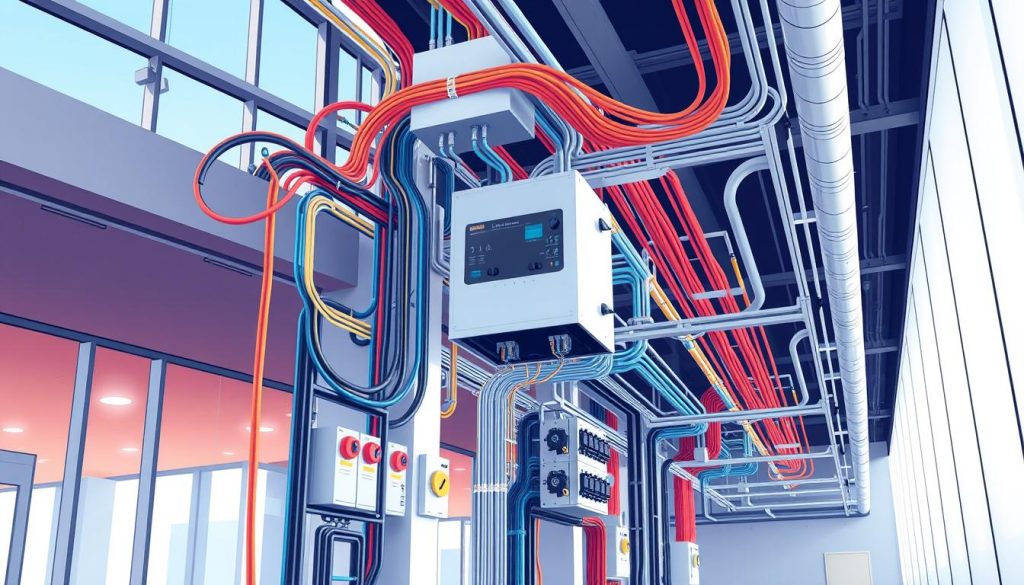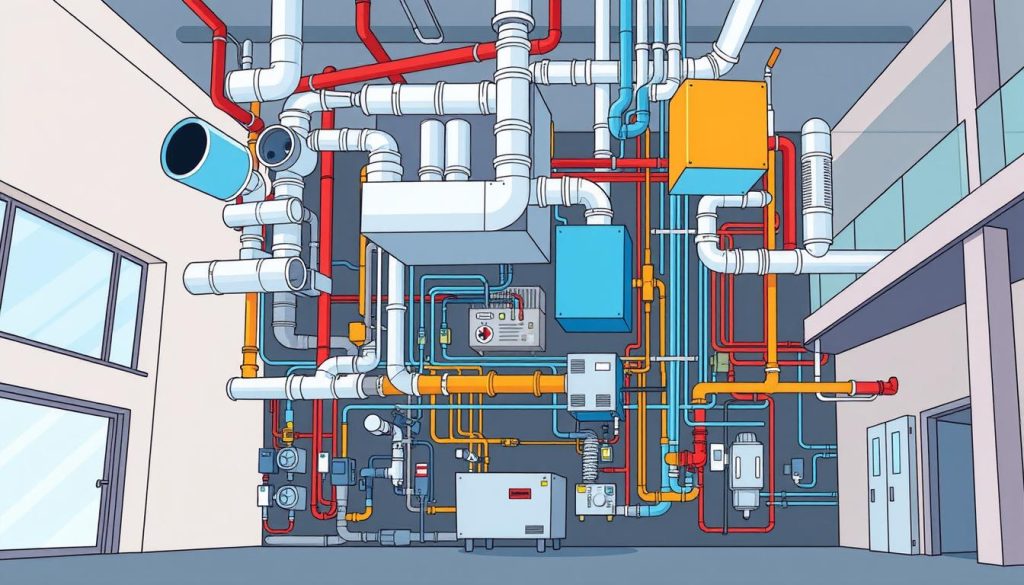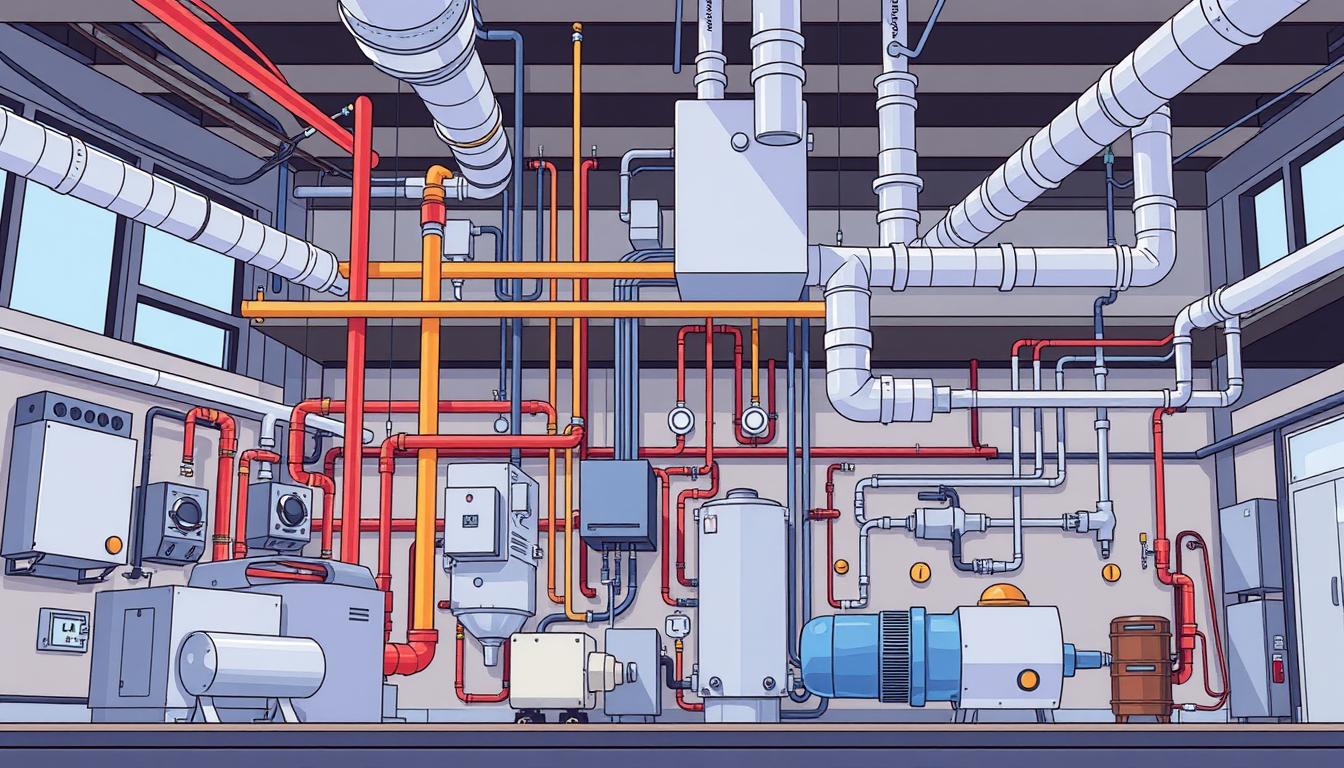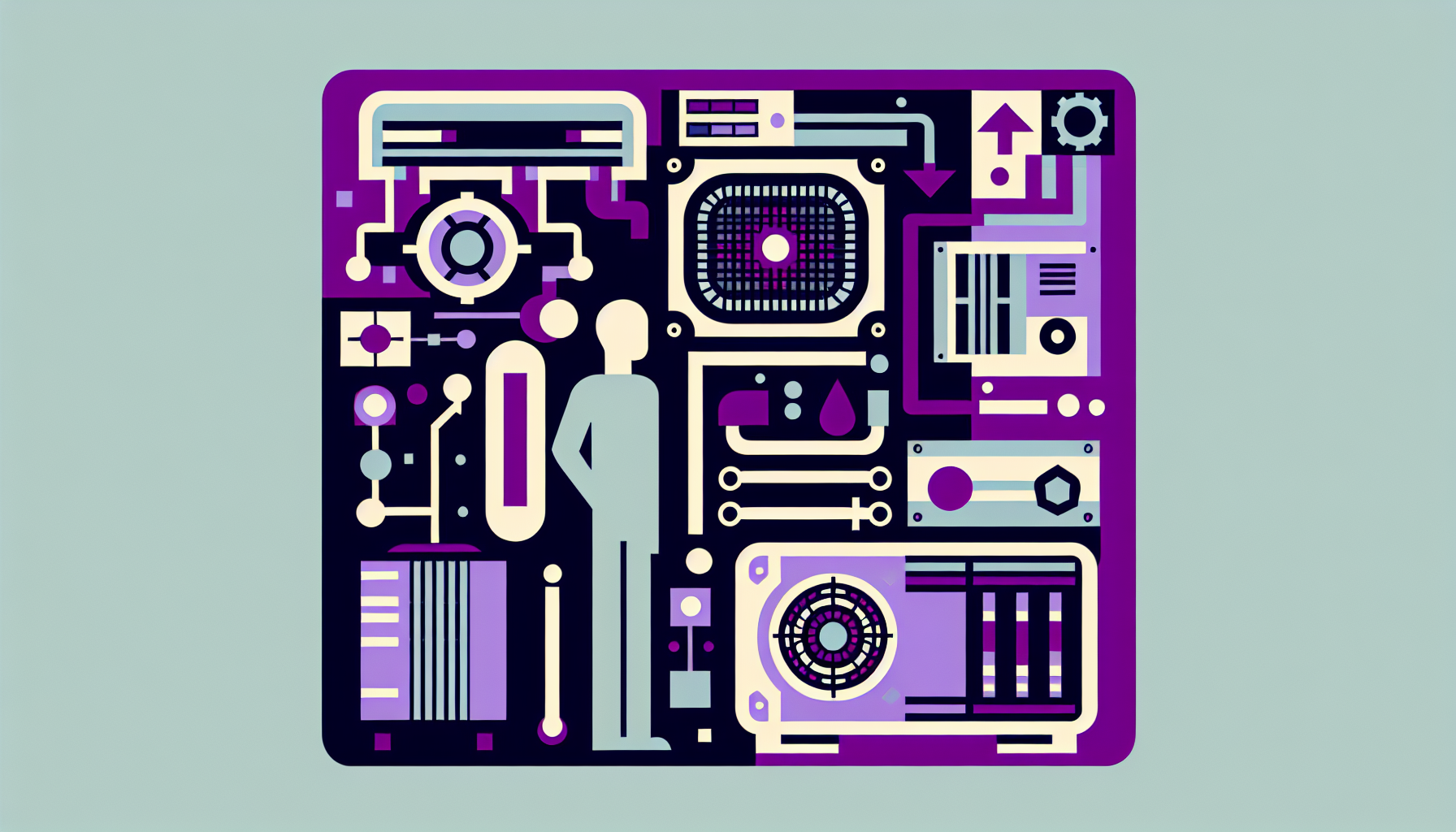If you work in construction or building maintenance, you’ve probably seen “MEP” with HVAC. MEP stands for Mechanical, Electrical, and Plumbing. It’s key to any modern building’s setup. Knowing how MEP and HVAC work together is vital for a building’s comfort and efficiency.
Key Takeaways
- MEP is a broader term that encompasses HVAC as one of the mechanical systems within a building’s infrastructure.
- HVAC systems are responsible for regulating the temperature, humidity, and air quality within a building.
- The MEP system includes the overall design, installation, and maintenance of the mechanical, electrical, and plumbing components that work together to ensure the building’s efficient and comfortable operation.
- MEP engineers are responsible for planning, designing, and coordinating the integration of these critical building systems.
- Understanding the interplay between MEP and HVAC is essential for optimizing the performance and cost-effectiveness of a building’s systems.
Definitions: Understanding MEP and HVAC
When we talk about building design and construction, “MEP” is a term you’ll hear a lot. But what does MEP mean, and how is it connected to HVAC? Let’s explore these important terms together.
What is MEP?
MEP stands for Mechanical, Electrical, and Plumbing. It covers the systems in a building that provide key services like heating, cooling, ventilation, electricity, and water supply. An MEP engineer designs, plans, and oversees the setup of these systems. They make sure the building works well and efficiently.
What is HVAC?
HVAC is short for Heating, Ventilation, and Air Conditioning. It’s a key part of the MEP system, focusing on heating, cooling, and air circulation in buildings. HVAC systems keep the indoor air comfortable, control temperature, and ensure good air quality.
To sum up, MEP is a wider term that includes HVAC and more. HVAC is a specific area within MEP. MEP engineering services bring together all these systems to make a building run smoothly and efficiently.
The Breakdown: Exploring MEP and Its Relation to HVAC
In the construction world, “MEP” stands for Mechanical, Electrical, and Plumbing systems. These systems are key for a building to work well and feel comfortable. They include heating, cooling, air, electricity, and water, making a place ready for people to live or work.
What Does MEP Mean in Construction?
MEP in construction means:
- Mechanical systems, like the equipment and ducts for heating, cooling, and air.
- Electrical systems, which cover power, lights, and communication.
- Plumbing systems, for water, drainage, and sanitation, including pipes and fixtures.
These systems work together to make a building comfortable, safe, and energy-smart. MEP engineering services are vital for designing, setting up, and keeping these systems running right. They make sure everything meets mep design for buildings and mep coordination in construction rules.
It’s important to integrate mechanical electrical plumbing systems well for a building’s success. Hvac mep contractors and sustainable mep design experts team up to make these systems efficient and effective. They help achieve the hvac mep definition and mep systems integration in any construction project.
The Mechanical Aspect of MEP
The mechanical part of the MEP system is key to a building’s function and efficiency. It includes the HVAC system and other important systems like audio and visual networks. These also include alarm systems, elevators, and escalators.
The HVAC system is at the core of the mechanical aspect. It keeps the indoor climate comfortable by controlling temperature, humidity, and air quality. The HVAC mep definition covers designing, installing, and maintaining these systems. This ensures a pleasant and healthy space for building occupants.
Other vital systems are also part of the mechanical aspect. Mep engineering services often integrate these systems. This ensures they work well together and perform optimally.
Designing the mechanical part of mep design for buildings is a big job. It needs the skills of experienced hvac mep contractors. They work with the MEP team to design, install, and maintain mechanical systems. This helps make the building efficient and sustainable.
Coordinating the mechanical, electrical, and plumbing systems in construction is crucial. This integration is key for mep systems integration. It helps create sustainable mep design solutions. These solutions improve the building’s performance and reduce its environmental impact.
The Electrical Aspect of MEP
The electrical part of the mechanical, electrical, and plumbing (MEP) system is key. It makes sure a building works right. This includes wiring, power, lights, and devices like computers and phones.
Electrical systems give power to the building’s parts. This includes the HVAC system.
The Importance of Electrical Systems
A good electrical plan is vital for safe and efficient power. Mechanical electrical plumbing (MEP) engineers team up with hvac mep contractors. They design the electrical systems with HVAC and other systems.
This teamwork is key for mep systems integration and a sustainable mep design.
The electrical part of MEP powers the building’s key parts. This includes lights, climate control, and security. Proper mep coordination in construction makes sure these systems work well together.
This ensures the building works well and efficiently.
The electrical part also helps with mep engineering services. This includes backup power, surge protection, and energy-saving lights. These features help the building run reliably and sustainably.
| Key Electrical Components in MEP | Function |
|---|---|
| Wiring and Power Distribution | Provide safe and efficient electrical power throughout the building |
| Lighting Systems | Illuminate the building’s interior and exterior spaces |
| Electronic Devices and Controls | Power and manage various building systems, such as HVAC, security, and communication |
| Emergency Power Systems | Ensure continuous power supply during outages or emergencies |

The Plumbing Aspect of MEP
The plumbing part of the MEP system is key in buildings. It deals with pipes and systems for water and waste. This includes bringing in clean water and taking out waste.
It’s important to plan plumbing well to avoid problems with other systems. Mechanical electrical plumbing experts work with hvac mep contractors and mep engineering services to make sure everything works together. They focus on mep design for buildings.
Key Considerations in Plumbing MEP Design
- Water supply and distribution
- Wastewater drainage and disposal
- Pipe sizing and layout
- mep coordination in construction to optimize system integration
- sustainable mep design principles to enhance energy efficiency
By focusing on these points, mep systems integration experts make plumbing work well with the building. This follows the hvac mep definition.
| Plumbing System Component | Purpose |
|---|---|
| Water Supply | Deliver clean, potable water to various fixtures and appliances throughout the building |
| Wastewater Drainage | Efficiently remove and transport waste liquids and solids from the building to the municipal sewer system |
| Pipe Network | Provide the necessary infrastructure for water distribution and waste management |
Knowing about plumbing in MEP helps everyone involved. It makes sure the whole mep engineering services work well together. This improves the building’s function, efficiency, and greenness.
What does MEP mean in HVAC?
In the world of heating, ventilation, and air conditioning (HVAC), “MEP” is key. MEP stands for “Mechanical, Electrical, and Plumbing.” It’s the infrastructure that supports the HVAC system in buildings or facilities. The HVAC system controls the indoor climate, while the MEP system includes the mechanical, electrical, and plumbing parts needed for it to work.
The MEP system is vital in building design and construction. It makes sure all subsystems, like power supply and water distribution, work together smoothly. Knowing about MEP in HVAC helps us see how building systems are complex and connected. They all work together to make indoor spaces comfortable and efficient.
Key Components of the MEP System in HVAC
- Mechanical: This includes HVAC equipment like air conditioning units and furnaces. It also includes ductwork and piping for air distribution.
- Electrical: The electrical part powers the HVAC equipment and controls. This ensures the system runs well and efficiently.
- Plumbing: Plumbing handles the water supply and drainage for the HVAC system. This includes the cooling tower or humidifier.
Understanding these three main parts helps us see the MEP system’s complexity and importance in HVAC design and implementation.
| MEP Component | Description | Importance in HVAC |
|---|---|---|
| Mechanical | HVAC equipment, ductwork, and piping | Responsible for the distribution and regulation of conditioned air |
| Electrical | Power supply, control systems, and automation | Ensures the proper operation and efficiency of the HVAC system |
| Plumbing | Water supply and drainage for HVAC components | Supports the cooling and humidification functions of the HVAC system |
Understanding MEP in HVAC shows us the complexity and importance of this integrated system. It’s crucial for creating a comfortable, efficient, and sustainable indoor environment.
The Roles and Responsibilities of an MEP Engineer
An MEP (Mechanical, Electrical, and Plumbing) engineer is crucial in the construction world. They plan, design, and manage the systems that keep a building running. Their skills in mechanical electrical plumbing, hvac mep definition, and mep engineering services make sure these systems work well together.
Planning and Designing MEP Systems
At the heart of an MEP engineer’s job is designing mep design for buildings, hvac mep contractors, and mep coordination in construction. They create detailed plans, set high standards, and use tools to check and evaluate. Their focus on mep systems integration and sustainable mep design ensures systems work together efficiently and are good for the environment.
MEP engineers work with architects and construction managers to turn designs into real systems. Their knowledge of mechanical electrical plumbing and hvac mep definition helps them solve problems early. This keeps the project on schedule and meets high standards.
| Key Responsibilities of an MEP Engineer | Description |
|---|---|
| System Design | Develop detailed plans for mechanical, electrical, and plumbing systems, ensuring they are integrated and optimized for the building’s needs. |
| Project Coordination | Collaborate with architects, construction managers, and other stakeholders to ensure seamless integration of MEP systems into the overall project. |
| Code Compliance | Ensure all MEP systems comply with relevant building codes, safety regulations, and environmental standards. |
| System Optimization | Continuously monitor and refine MEP systems to enhance energy efficiency, sustainability, and overall performance. |
MEP engineers use their knowledge in mep engineering services and mep coordination in construction to create buildings. These buildings are not just functional but also save energy and are good for the environment.
Factors Affecting the Cost of a New HVAC System
Installing a new HVAC system in a building can cost a lot, depending on several factors. As an MEP professional, knowing these factors is key. It helps in giving accurate estimates and ensuring clients make smart choices.
The design complexity of the HVAC system is a big factor. A complex system with advanced features costs more than a simple one. The size of the building also matters. Bigger buildings need bigger HVAC systems, which means higher costs.
The efficiency of the HVAC system is another important factor. High-efficiency systems save energy and money in the long run. But, they might cost more upfront. The location and accessibility of the installation site also affect the cost. Site preparation, transportation, and labor costs can vary.
The quality of the HVAC components and how well they integrate with other systems matter too. Better components and integration mean a more reliable system. But, they can also be pricier.
Understanding these factors helps MEP professionals give accurate cost estimates. They can design and install HVAC systems that fit their clients’ needs and budgets.

MEP and HVAC Interplay: A Cohesive Approach
Building systems like mechanical, electrical, and plumbing (MEP) are closely tied to the heating, ventilation, and air conditioning (HVAC) system. Together, they ensure a building’s comfort, safety, and function. The HVAC system is key, managing temperature, humidity, and air quality.
Designing MEP and HVAC systems together is essential for top performance and energy use. MEP engineers and HVAC designers must work closely. HVAC contractors are vital in making sure all systems work well together.
Also, sustainable design is key in the relationship between MEP and HVAC. Using energy-saving technologies helps buildings be eco-friendly and cheaper to run.
How do MEP and HVAC systems work together in a building?
MEP and HVAC systems rely on each other. Mechanical systems move air, water, and fluids. Electrical systems power the building, and plumbing handles water and waste. HVAC controls temperature, humidity, and air quality.
What are the benefits of integrating MEP and HVAC systems?
Combining MEP and HVAC systems offers many advantages. It boosts energy efficiency, cuts costs, and improves comfort. This approach makes buildings more efficient and sustainable over time.
| Benefit | Description |
|---|---|
| Energy Efficiency | Integrating systems reduces energy use by optimizing performance and cutting waste. |
| Cost Savings | United systems lower operating and maintenance costs, leading to long-term savings. |
| Occupant Comfort | Seamless MEP and HVAC integration ensures a comfortable, healthy indoor space. |
The connection between MEP and HVAC systems is vital for building success. A holistic approach leads to energy-efficient, cost-effective, and comfortable buildings.
Conclusion
In the world of building systems, “MEP” is key. It stands for Mechanical, Electrical, and Plumbing. These parts are vital for a building to work well and feel comfortable.
HVAC, or Heating, Ventilation, and Air Conditioning, is a big part of MEP. It keeps the air inside just right, making sure everyone is happy and healthy.
We’ve looked closely at how MEP and HVAC work together. We’ve talked about what each does and how they fit together. We’ve also covered what an MEP engineer does and how much a new HVAC system might cost.
Knowing how these systems connect helps you in building design and construction. It makes sure your projects are not just good but also save energy and are kind to the planet.
The industry is always changing, and so is the need for better MEP and HVAC solutions. By keeping up with new ideas and technologies, you can lead the way. You’ll give your clients the best and help make buildings better for our future.





0 Comments